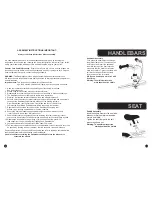
19
a. Adjusting the quick release mechanism
The wheel hub is clamped in place by the force of the quick release cam pushing against one dropout and
pulling the tension adjusting nut, by way of the skewer, against the other dropout. The amount of clamping
force is controlled by the tension adjusting nut. Turning the tension adjusting nut clockwise while keeping
the cam lever from rotating increases clamping force; turning it counterclockwise while keeping the cam
lever from rotating reduces clamping force. Less than half a turn of the tension adjusting nut can make the
difference between safe clamping force and unsafe clamping force.
!
b. Front Wheel Secondary Retention Devices
Most bicycles have front forks which utilize a secondary wheel retention device to reduce the risk of the
wheel disengaging from the fork if the quick release is incorrectly adjusted. Secondary retention devices
are not a substitute for correct quick release adjustment.
Secondary retention devices fall into two basic categories:
(1) The clip-on type is a part which the manufacturer adds to the front wheel hub or front fork.
(2) The integral type is molded, cast or machined into the outer faces of the front fork dropouts.
Ask your dealer to explain the particular secondary retention device on your bike.
!
WARNING: Do not remove or disable the secondary retention device. As its name implies, it
serves as a back-up for a critical adjustment. If the quick release is not adjusted correctly, the
secondary retention device can reduce the risk of the wheel disengaging from the fork. Removing
or disabling the secondary retention device may also void the warranty.
Secondary retention devices are not a substitute for correct quick release adjustment. Failure to
properly adjust the quick release mechanism can cause the wheel to wobble or disengage, which
could cause you to loose control and fall, resulting in serious injury or death.
2. Removing and Installing Quick Release Wheels
!
a. Removing a Quick Release Front Wheel
!
CAUTION: If your bike has a disc front brake, exercise care in touching it. Discs have sharp
edges and can get very hot during use.
!
(1) If your bike has rim brakes, disengage the brake’s quick-release mechanism to
increase the clearance between the tire and the brake pads (See Section 4.C fig.
12 through 13).
(2) Move the wheel’s quick-release lever from the locked or CLOSED position to the
OPEN position (figs. 6 & 7).
(3) If your front fork does not have a secondary retention device go to step (5).
(4) If your front fork has a clip-on type secondary retention device, disengage it and
go to step (5). If your front fork has an integral secondary retention device,
loosen the tension adjusting nut enough to allow removing the wheel; then go to
the next step.
(5) Raise the front wheel a few inches off the ground and tap the top of the wheel
with the palm of your hand to release the wheel from the front fork.
Fig.6
Fig.7
Содержание - V8.0
Страница 1: ...VERSION 8 0...
















































